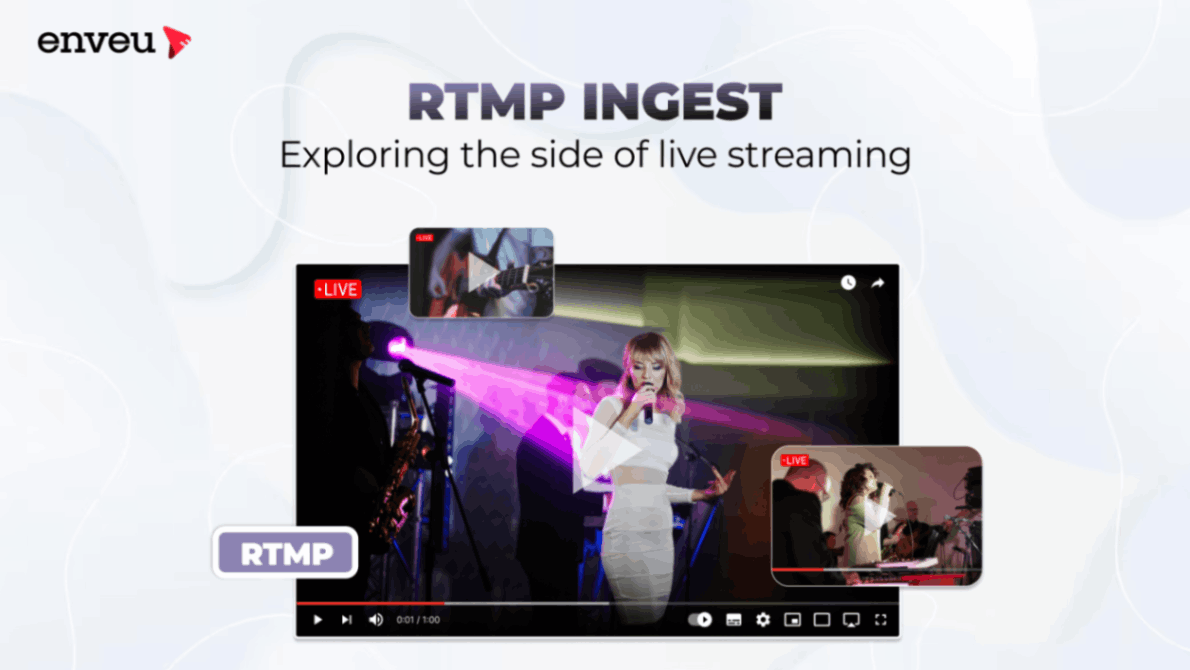RTMP Ingest: Exploring the Side of Live Streaming - Enveu
RTMP Ingest Explored: Elevate Your Live Streaming Success and Innovation with In-Depth Insights and Expert Guidance

Live streaming has exploded in popularity in recent years, with millions of people tuning in to watch their favourite content creators, celebrities, and athletes on platforms like Twitch, YouTube, and Facebook Live.
According to a recent report by SkyQuest Technology, the global video streaming market is expected to reach a value of USD 932,000.0 million by 2027, at a CAGR of 25.0% over the forecast period (2021 – 2027). At the heart of this trend is RTMP (Real-Time Messaging Protocol), a popular protocol that enables the seamless transmission of audio, video, and data in real-time to a media server.
Table of Contents
ToggleLet us talk about RTMP and RTMP ingest
RTMP (Real-Time Messaging Protocol) is the one we use for sending audio, video streaming, as well as data in real time from Flash Player to the server. It was developed by Macromedia (now Adobe), and is currently utilised in live streaming, video on demand, real-time text messaging, as well as online video discussions.
In its relation with stream video on demande or SVOD, RTMP matters, but it is less relevant than before. This enables it to do low latency streaming, which is very vital for broadcasters streaming key events. Moreover, it has gained popularity due to low buffering, which greatly improves customer satisfaction. Some of the ways through which low latency, no-buffer streaming content can be delivered include RTMP streaming.
Adaptive-bitrate streaming and some web conferencing applications also use RTMP technology. The RTMP protocol has various usage that shall be elaborated below.
RTMP ingest lets the user upload live streaming content to a media-server that is designed for Internet distribution. The service is used by broadcasters and streaming platforms to forward feeds from the encoder, camera, or any source to subscribers.
RTMP ingest is a type of encoding and delivering that enables live video originating in the encoder to reach an internet video platform using RTMP technology. This requires the use of a simple to access cheap RTMP encoder as compared to those encoding by using other streams. One may not to need an online video platform for streaming as RTMP encoder can feed directly on the CDN or video player
Streaming using RTMP ingest is often associated with delivery of live video stream to consumer devices, for instance, through protocols such as HLS and/or DASH.
Advantages of RTMP ingest
Using RTMP ingest has a number of advantages:
- RTMP helps in avoiding or reducing buffering as a video plays or stops for additional data.
- Reduction of Buffering – One of the reasons why buffering is reduced is that RTMP has a fairly low latency when compared to other streaming protocols hence, it minimizes the gap between the source and the viewer.
- Reliable streaming at an affordable price – With RTMP being effective in delivering stable broadcasting and eliminating any extra infrastructure needed on one’s end makes live streaming much cheaper. Furthermore, RTMP efficiently uses network resources to facilitate delivery of quality streams consuming minimal bandwidth and reducing cost. This enables low latency, high quality streams and minimal buffering allowing for smooth viewing on the part of the user.
RTMP Ingest vs. RTMP Streaming
Two different aspects of real-time messaging protocol – RTMP, include RTMP ingest and RTMP streaming. RTMP ingest entails acquiring and compressing, opening up a channel to an RTMP server, and transferring the compressed content to the server for transmission.
RTMP streaming is referred that encrypted audio and video data is transferred from an RTMP server to multiple clients which may include media players, web browsers and other internet applications in a real time basis. For instance, it may transmit through RTMP or other compatible protocols like HLS and DASH.
Two reasons led to decrease in utilisation of RTMP streaming that it was created for and Flash video player which is its counterpart. First, it lacked the capacity to facilitate streaming on mobile technology and when broadcasters discovered that more people were accessing the web via their cell phones, they had no time to waste. The second factor why RTMP streaming is now considered inferior relates to new technology. All these make RTMP distribution focus on video ingest rather than streaming.
HLS or RTMP: Which Streaming Protocol Should Broadcasters Choose?
HTTP Live Streaming (HLS) and Real-Time Messaging Protocol (RTMP) are two different protocols for streaming audio, video, and data over the Internet.
HLS is an HTTP-based protocol developed by Apple for streaming video and audio content to devices such as smartphones, tablets, and computers. It allows HLS streams to be played back on a wide range of devices, as most modern web browsers support HTTP.
RTMP on the other hand is a protocol that uses a persistent connection between the client and the server to stream video and audio content from a web server to a Flash player, such as the one used by many websites to display video content. Interestingly, RTMP ingest can also be used in combination with HLS streaming to get the lowest latency possible.
Final thought
Thanks to the repositioning of the RTMP protocol for RTMP ingest and the introduction of HLS delivery, live streaming technology is at its peak. This technological combination is robust and dependable, but given the rate at which live streaming technology is advancing, we are certain that it is not the ultimate form of the live streaming process.
Interested in learning more about RTMP and its function in live streaming? You can contact a member of our knowledgeable support staff who is available to address any questions you may have.